Search the Special Collections and Archives Portal
Search Results
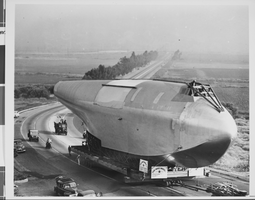
Photograph of Howard Hughes' Hercules, Culver City, California, June 16, 1946
Date
1946-06-16
Archival Collection
Description
Description given with photo: "Hull of "Hercules" Starts Journey to Assembly Dock, Culver City, Calif. - The 220-foot-long fuselage of Howard Hughes' gigantic airplane crawls down the highway on truck dollies after leaving the Culver City, Calif., plant. the hull is on its way to the graving dock for assembly at Terminal Island, Calif., 28 miles away. Note size of man on top of hull. NY EUR CAN. Credit (ACME) 6/16/46"
Image
Wilbur Square Park in Boulder City, Nevada, approximately 1937-1938
Level of Description
File
Archival Collection
L. F. Manis Photograph Collection
To request this item in person:
Collection Number: PH-00100
Collection Name: L. F. Manis Photograph Collection
Box/Folder: Folder 80
Collection Name: L. F. Manis Photograph Collection
Box/Folder: Folder 80
Archival Component
Waters of Lake Mead rise to base of Lost City Restorations, 1938
Level of Description
File
Archival Collection
Elbert Edwards Photograph Collection
To request this item in person:
Collection Number: PH-00214
Collection Name: Elbert Edwards Photograph Collection
Box/Folder: Folder 06
Collection Name: Elbert Edwards Photograph Collection
Box/Folder: Folder 06
Archival Component
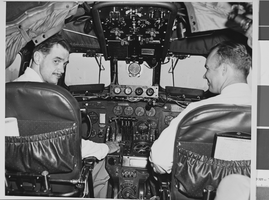
Photograph of Howard Hughes installing radar, Culver City, California, May 03, 1947
Date
1947-05-03
Archival Collection
Description
Description given with photo: "Hughes Pilots Radar-Equipped Plane Culver City, Calif. -- First passenger plane equipped with radar is flown in demonstration May 1st by Howard Hughes (left) and co-pilot R.C. Loomis over Culver City. Pilots using this equipment will be warned of approaching obstacles by lights flashing on radar panel. Two lights (lefts) with 2,000-foot range, are used to guarantee clearance over mountains; two lights (right) with 500-foot range, are a safety device for approaches and landings. Either set of lights warns against approaching aircraft. Trans-World Airline plans to install radar on its passenger planes. Credit (ACME) 5-3-47."
Image
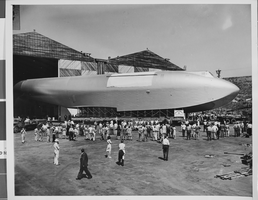
Photograph of Howard Hughes' Hercules, Culver City, California, June 16, 1946
Date
1946-06-16
Archival Collection
Description
Description given with photo: "Hercules Fuselage Leaves Hangar, Calver City, Calif. - The hull of Howard Hughes' huge cargo flying boat, the Hercules, largest airplane in the world leaves hangar in the Culver City, Calif., plant to begin a 28-mile trip to Terminal Island, Calif., by truck and dolly. the 220-foot long hull-fuselage will follow the path of the wing sections to the graving dock where the air giant will be assembled. Credit Line (ACME) 6/16/46."
Image
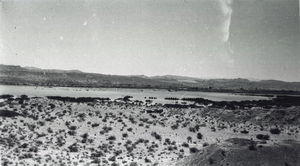
Photograph of the Lost City site and Lake Mead, near Overton, Nevada, spring 1938
Date
1938
Archival Collection
Description
Long shot of the Lost City site (Pueblo Grande de Nevada), near Overton, Nevada, with the northwest arm of Lake Mead in the distance. The area is near the ruins of St. Thomas, Nevada, another nearby extinct town, submerged by Lake Mead.
Image

Photograph of a grinding slab metate at the Lost City, Clark County, before 1938
Date
1930 to 1938
Archival Collection
Description
Grinding slab metate at the Lost City with numerous holes
Transcribed Notes: Notes on photo sleeve Los City, Nevada. Holes and stones were used to grind grains, etc. (Credit: W.A. Davis); 'Gypsum Cave, bedrock mortars near cave' - W.A. Davis
Image
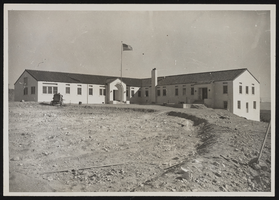
Photograph of a museum building, Boulder City (Nev.), January 10, 1938
Date
1938-01-10
Archival Collection
Description
Museum and Administration Building stands in a vacant dirt field. An American flag waves in front of the structure.
Image
Howard Hughes with two others inside the Hughes Tool Company factory, 1938 July 30
Level of Description
File
Archival Collection
Howard Hughes Professional and Aeronautical Photographs
To request this item in person:
Collection Number: PH-00321
Collection Name: Howard Hughes Professional and Aeronautical Photographs
Box/Folder: Folder 05
Collection Name: Howard Hughes Professional and Aeronautical Photographs
Box/Folder: Folder 05
Archival Component
Howard Hughes and employees visiting Hughes Tool Company in Houston, Texas, 1938 July 30
Level of Description
File
Archival Collection
Howard Hughes Professional and Aeronautical Photographs
To request this item in person:
Collection Number: PH-00321
Collection Name: Howard Hughes Professional and Aeronautical Photographs
Box/Folder: Folder 08
Collection Name: Howard Hughes Professional and Aeronautical Photographs
Box/Folder: Folder 08
Archival Component
Pagination
Refine my results
Content Type
Creator or Contributor
Subject
Archival Collection
Digital Project
Resource Type
Year
Material Type
Place
Language
Records Classification
